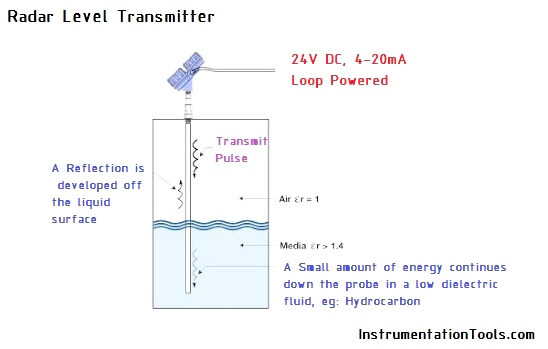Guided wave radar (GWR) is also called time domain reflectometry (TDR) or micro-impulse radar (MIR).
Basic principle
In a Guided Wave Radar installation, the GWR is mounted on the top of the tank or chamber, and the probe usually extends to the full depth of the vessel. A low energy pulse of microwaves, travelling at the speed of light, is sent down the probe. At the point of the liquid level (air / water interface) on the probe, a significant proportion of the microwave energy is reflected back up the probe to the transmitter.

The transmitter measures the time delay between the transmitted and received echo signal and the on- board microprocessor calculates the distance to the liquid surface using the formula:
Distance = (Speed of light x time delay) / 2
Once the transmitter is programmed with the reference gauge height of the application – usually the bottom of the tank or chamber – the liquid level is calculated by the microprocessor.
The basic equation for measuring the tank level is
Level = Tank Height – Distance
Because a proportion of the pulse will continue down the probe through low dielectric fluids, a second echo can be detected from an interface between two liquids at a point below the initial liquid level.
This characteristic makes guided wave radar a good technique for measuring liquid/liquid interfaces such as oil and water and measuring through some foams.
Guided wave radar can be used in vessels with tight geometry, in chambers, and in tanks of all sizes. Advanced GWR also works well in low dielectric and turbulent applications. Because it is not dependent on reflecting off a “flat” surface, it works well with many powders and grains as well as liquids with slanted surfaces caused by vortices.
Guided wave radar technology Benefits
- No moving parts and no re-calibration minimizes maintenance
- Direct level measurement means no compensation needed for changing process conditions (i.e. density, conductivity, temperature, and pressure)
- Handles vapor and turbulence well
- Suitable for small tanks, difficult tank geometry, and interfering obstacles
- Allows for easy upgrade
- Top down installation minimizes risk for leakages
Advantages
- Guided wave radar (GWR) provides an accurate and reliable measurement for both level and interface, and can be used in a wide variety of applications.
- It is a top-down, direct measurement as it measures the distance to the surface.
- GWR can be used with liquids, sludges, slurries, and some solids.
- A key advantage of radar is that no compensation is necessary for changes in the density, dielectric, or conductivity of the fluid.
- Changes in pressure, temperature, and most vapor space conditions have no impact on the accuracy of radar measurements.
- In addition, radar devices have no moving parts
- So maintenance is minimal. GWR is easy to install and can easily replace other technologies, such as displacer and capacitance, even while there is liquid in the tank.
Limitations
While guided wave radar works in many conditions, some precautions need to be taken with respect to probe choice. Several probe styles are available and the application, length, and mounting restrictions influence their choice. Unless a coax-style probe is used, probes should not be in direct contact with a metallic object, as that will impact the signal. If the application tends to be sticky or coat, then only single lead probes should be used. Some advanced GWRs on the market have advanced diagnostics, with the ability to detect build-up on the probe. Chambers with a diameter less than 3 in. (75 mm) may cause problems with build-up and may make it difficult to avoid contact between chamber wall and probe.